2.1 实验动物数量分析 16只C57BL/6小鼠与16只APP/PS1小鼠全部进入结果分析。
2.2 水迷宫实验结果 对定位航行阶段6 d的逃逸潜伏期记录并进行统计学分析,同时还记录了定位航行时的小鼠游泳速度,见图3。对照组、对照+磁刺激组、痴呆组、痴呆+磁刺激组小鼠游泳速度比较差异均无显著性意义,从而排除运动对学习记忆的影响。4组小鼠都有一定学习能力,在相同天数下,两组痴呆小鼠逃逸潜伏期高于两组正常小鼠,表明阿尔茨海默病导致小鼠学习能力下降。
小鼠水迷宫空间探索阶段数据统计结果见图4。对小鼠平台象限时间所占百分比分析可得,基因[F(1,30)=9.221,P <
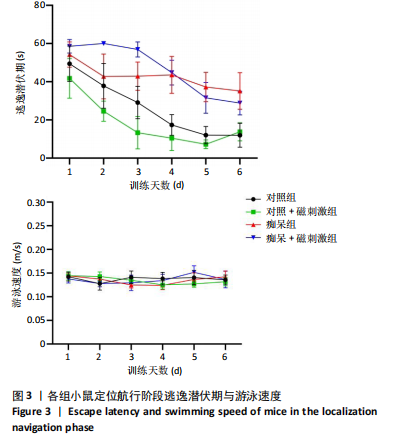
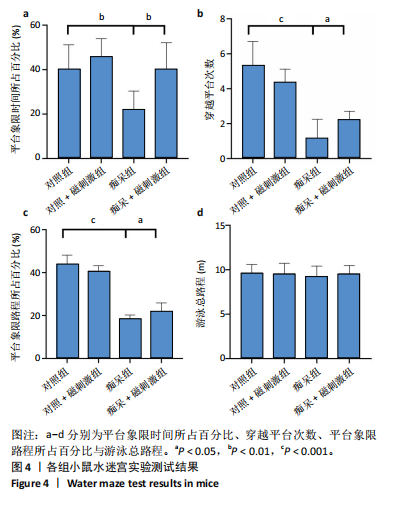
0.01]与刺激[(F(1,30)=12.214,P < 0.01]均产生了显著影响。组间比较结果显示,对照组与痴呆组、痴呆+磁刺激组与痴呆组小鼠之间平台象限时间所占百分比较差异均有显著性意义(P < 0.01)。
对小鼠穿越平台次数分析可得,基因表现出了显著影响[F(1,30)=9.221,P < 0.01],刺激没有产生显著影响[F(1,30)=0.175,P > 0.05]。组间比较结果显示,痴呆组小鼠所穿越原平台次数显著低于对照组(P < 0.001),痴呆+磁刺激组小鼠穿越平台次数显著高于痴呆组(P < 0.05)。
对小鼠平台象限路程所占百分比分析可得,基因产生了显著影响[F(1,30)=123.791,P < 0.001],刺激没有产生显著影响[F(1,30)=1.388,P > 0.05]。组间比较结果显示,痴呆组小鼠平台象限路程所占百分比显著低于对照组(P < 0.001),痴呆+磁刺激组平台象限路程所占百分比显著高于痴呆组(P < 0.05)。
对小鼠运动总路程分析可得,基因[F(1,30)=0.196,P > 0.05]与刺激[F(1,30)=1.112,P > 0.05]对小鼠总路程均没有产生显著影响。组间比较结果显示,4组小鼠总游泳路程比较差异均无显著性意义(P > 0.05)。
2.3 全细胞膜片钳技术分析结果
2.3.1 动作电位 在全细胞膜片钳记录动作电位的实验中,选择电流钳记录模式。诱发刺激程序设置为以0 pA为初始值,步长为10 pA,时长为500 ms的多个去极化脉冲电流。动作电位的放电频率与单个动作电位分析指标见图5。
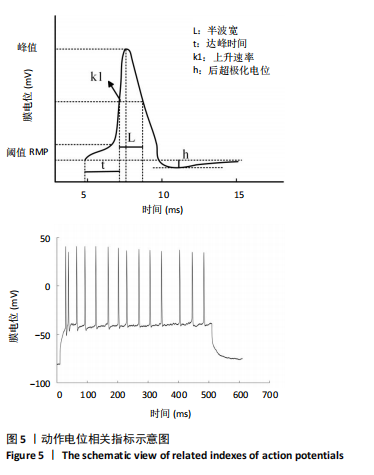
4组小鼠神经元静息膜电位见图6a。4组小鼠神经元静息膜电位存在显著差异,基因[F(1,22)=1.851, P > 0.05]与刺激[F(1,22)=0.604,P > 0.05]对静息膜电位均没有产生显著影响,基因与刺激的交互作用对静息膜电位产生了显著影响[F(1,22)=14.608,P < 0.01]。组间比较结果显示,痴呆组小鼠静息膜电位显著低于对照组(P < 0.05),痴呆+磁刺激组小鼠静息膜电位显著高于痴呆组(P < 0.001)。
神经元500 ms内动作电位放电频率结果见图6b。基因对放电频率产生了显著影响[F(1,22)=17.514, P < 0.01],刺激对小鼠放电频率没有产生显著影响[F(1,22)=0.216,P > 0.05]。组间比较结果显示,痴呆组小鼠放电个数显著高于对照组(P < 0.001),痴呆+磁刺激组放电个数与痴呆组相比差异均无显著性意义(P > 0.05)。
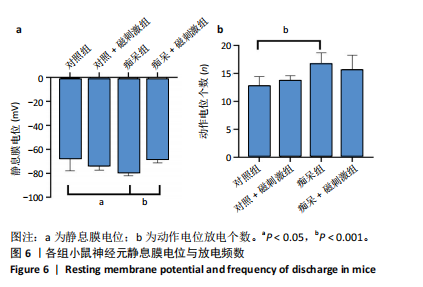
单个动作电位的阈值、达峰时间、峰值、最大上升斜率、后超极化电位、半波宽等指标见图7所示。由图7a可知,基因对动作电位阈值产生了显著影响[F(1,22)=7.371,P < 0.05],刺激对小鼠动作电位阈值产生了显著影响[F(1,22)=22.336,P < 0.001]。组间比较结果显示,痴呆组小鼠阈值显著高于对照组(P < 0.01),痴呆+磁刺激组阈值显著低于痴呆组(P < 0.01),对照+磁刺激组阈值显著低于对照组(P < 0.001)。
由图7b可知,基因对动作电位达峰时间产生了显著影响[F(1,22)=4.308,P < 0.05],刺激对小鼠动作电位达峰时间没有产生显著影响[F(1,22)=0.016,P > 0.05]。组间比较结果显示,痴呆组小鼠达峰时间显著低于对照组(P < 0.05),痴呆+磁刺激组达峰时间与痴呆组比较差异无显著性意义(P > 0.05)。
由图7c可知,基因对动作电位峰值没有产生显著影响[F(1,22)=0.672,P > 0.05],刺激对小鼠动作电位峰值没有产生显著影响[F(1,22)=3.907,P > 0.05]。经组间分析结果显示,痴呆组小鼠峰值显著低于对照组(P < 0.001),痴呆+磁刺激组峰值显著高于痴呆组(P < 0.05)。
由图7d可知,基因对动作电位最大上升速率产生了显著影响[F(1,22)=113.797,P < 0.001],刺激对小鼠动作电位最大上升速率产生了显著影响[F(1,22)=174.166,P < 0.001]。组间比较结果现实,痴呆组小鼠最大上升速率显著低于对照组(P < 0.01),痴呆+磁刺激组最大上升速率显著高于痴呆组(P < 0.01)。
由图7e可知,基因对动作电位后超极化电位没有产生显著影响[F(1,22)=3.103,P > 0.05],刺激对小鼠动作电位后超极化电位产生了显著影响[F(1,22)=49.655,P < 0.001]。组间比较结果显示,痴呆组小鼠后超极化电位显著高于对照组(P < 0.001),痴呆+磁刺激组后超极化电位显著低于痴呆组(P < 0.001)。
由图7f可知,基因对动作电位半波宽产生了显著影响[F(1,22)=11.088,P < 0.01],刺激对小鼠动作电位半波宽产生了显著影响[F(1,22)=7.801,P < 0.05]。组间比较结果显示,痴呆组小鼠半波宽显著短于对照组(P < 0.01),痴呆+磁刺激组半波宽与痴呆组比较差异无显著性意义(P > 0.05)。

2.3.2 K+通道 通过IA、IK的Ⅰ-Ⅴ刺激程序,可以得到瞬时外向钾电流(IA)和延时整流钾通道电流(IK),以膜电位为横坐标,电流峰值峰值为纵坐标,绘制Ⅰ-Ⅴ曲线,见图8。
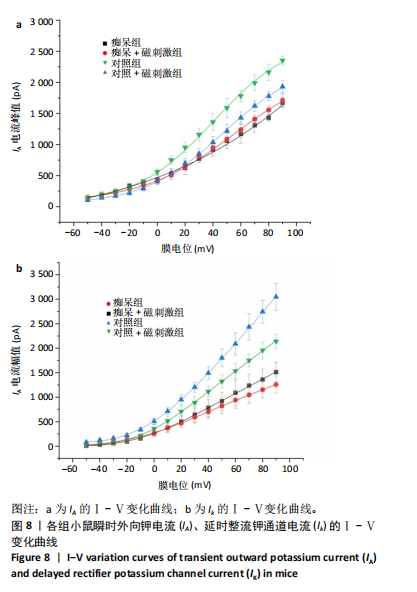
从图中可以看出,4组IA、IK电流的峰值都随着膜电位的升高而升高,在相同膜电位下,对照组IA、IK电流峰值显著高于痴呆组;经重复经颅磁刺激后IA、IK电流峰值均有所升高,随着电压的升高,重复经颅磁刺激对痴呆组IK电流峰值的提高更明显。
通过IA、IK的激活刺激程序可以得到一组电流值,使用公式(1)将电流值转换为电导值,以膜电位为横坐标,G/Gmax为纵坐标,绘制4组电导值的散点图,然后使用玻尔兹曼方程(2)对散点图进行拟合得到曲线见图9,激活曲线参数见表2。

式中,G为电导,I为不同电压下的峰值电流,Vm为膜电位,Vrev为翻转电位(电流值为零时的膜电位),V1/2为半数激活电压,k为斜率因子。

由表2与图9可以看出,4条曲线的形状相似,与对照组相比,痴呆组曲线向右偏移,痴呆组与对照组IA、IK的半数激活电压V1/2、斜率因子比较差异均有显著性意义(P均< 0.001),阿尔茨海默病使得神经元向着去极化方向偏移,而重复经颅磁刺激治疗加快了这种偏移。斜率因子变大,表示电流激活对膜电位的变化非常敏感,可能导致电流在电压变化时的响应更为迅速和明显,这可能影响神经元的电活动,使其更加灵活和敏感。
通过IA失活刺激程序得到一组电流值,此为IA失活过程。用电流峰值I/Imax做出散点图,然后使用公式(3)对得到的散点图进行拟合得到曲线见图10a,失活曲线参数见表3。
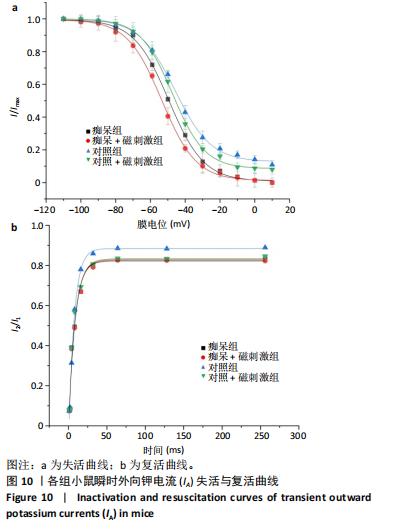
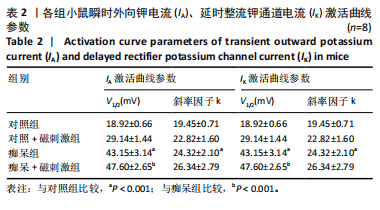
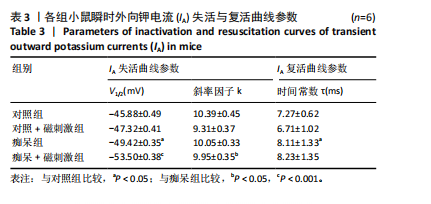

式中,I为不同膜电位下的电流峰值,Imax为最大峰值,Vm为膜电位,V1/2为半数失活电压,k为斜率因子。
由图10a中可以看出4条曲线形状相似,与对照组相比,痴呆组曲线向左偏移,斜率因子k无显著变化;痴呆+磁刺激组相比于痴呆组曲线也向左偏移,斜率因子k显著小于痴呆组。由此可知,阿尔茨海默病能够使得IA的失活特性发生改变,使其向着去极化方向偏移,而重复经颅磁刺激使得痴呆组的IA曲线向着去极化方向偏移,减小斜率因子,缩短瞬时外向钾通道的开放时间。斜率因子小表示电流失活对膜电位的变化不太敏感,这可能导致电流的失活过程在较宽范围内的膜电位变化下都能发生,使得电流对于细胞膜的电压变化更加温和。
通过IA复活刺激程序得到一组钾电流值,此为IA复活过程。以时间为横坐标,以I2与I1的比值为纵坐标绘制散点图。利用公式(4)对散点图进行拟合得到的曲线见图10b,失活曲线参数见表3。

式中,I1为条件脉冲的峰电流,I2为测试脉冲的峰电流,τ为恢复时间常数。
由图10b中可以看出,痴呆组相比于对照组曲线向右偏移,IA失活后的复活时间常数也显著大于对照组,痴呆+磁刺激组时间常数显著延长。长时间常数意味着电流在激活或失活过程中的变化较为缓慢,这可能导致电流对膜电位的变化不敏感,其响应可能会在较长时间尺度上发生。由于激活或失活过程缓慢,电流可能在一次激活后持续一段时间,这可能导致神经元的去极化过程较为持久,影响神经元的兴奋性和放电模式。









